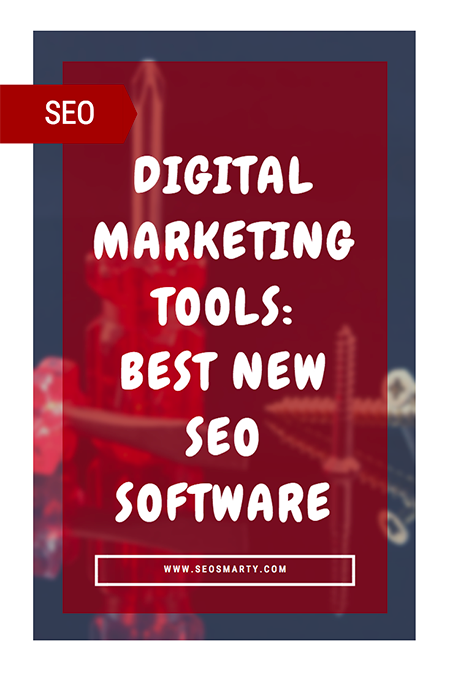SEO
Best New SEO Software I Use

I love tools and I have a pretty solid collection of tolls I am using daily. In this article I share my most recent SEO software that I really love.
[Disclaimer: I may be paid a commission if you buy the premium subscription after clicking some links below. Or I may be not]All-in-One Marketing Dashboard Tools
There are a few comprehensive SEO suites that report on anything under the sun, from on-page issues to rankings and backlinks. Surprisingly, none of them is enough for me, so I use these four depending on the tasks I am dealing with:
| Ahrefs | Semrush | Serpstat | Spyfu | |
| Features | Ranking analysis, keyword research, on-page audit, position monitoring, SERP analysis, competitive analysis, backlink research | |||
| Price | $99 | $99.95 | $19 | $39 |
They all have free trials, so you can totally check each of them before you decide which one you like best.
Here are my favorite features inside each platform (and actually why I have to use all of them):
Ahrefs: Advanced Keyword Research and Analysis
Ahrefs most powerful feature is their Keyword Explorer. Not only will it extend your keyword and calculate keyword difficulty (i.e. how high the organic competition is), it will also suggest related keywords. This helps a ton in finding alternative, less competitive keywords to focus on:

Advanced Keyword Research and Analysis
Semrush: Multi-Feature Position Tracking
Semrush is my very first SEO dashboard I’ve ever used. They have a ton of historical data and their tools are simply awesome. My favorite one is their ranking position tracker. I love the fact that you can track positions inside “Featured Snippets” and “People Also Ask” sections:

Multi-Feature Position Tracking
Serpstat: Keyword Clustering
Serpstat‘s Clustering feature is one of its kind. It helps you organize your keyword lists by relevancy, make sense of thousands of queries, understand your niche better and optimize for several keywords at a time. It’s a must-use feature for every topic research because it shows you how you can optimize one page for several queries.

Keyword Clustering
Spyfu: Indepth Position History
Spyfu is one of the oldest all-in-one marketing dashboards out there. Initially focusing on PPC tracking, the tool has successfully expanded into organic SEO. My by far favorite feature there is their organic history feature visualizing which pages were ranking for a give query throughout the years:

Indepth Position History
Web Analytics Tools
Finteza
Finteza is a great – and more importantly independent – web analytics suit that is both affordable and feature-rich. You can use Finteza to monitor your traffic channels, traffic quality and conversions. The tool also comes with a powerful feature set allowing you to create your own, again, independent, on-site advertising program as well as set up re-marketing campaigns.

Finteza analytics allows to slice and dice your data to research every demographic
Marketing Productivity and Collaboration Tools
I’ve tried hundreds tools to get organized and I’ve worked with many of them on a continuous basis, including Zoho, Trello, etc. Here I am featuring my currently favorite productivity and collaboration tool but I may expand the article with more options going forward.
Renderforest
Renderforest is a multi-feature content creation and branding tool that can help you create diverse content assets including videos, animations and branded mockups. Its online video creation platform is an exciting one because it can help anyone create professional videos without spending extra budgets on third-party creators or expensive software. You can create explainer videos, whiteboard videos, cartoon animations, and so much more.

Zenkit
Zenkit is the to-do list and mindmap builder with cool collaboration features. Zenkit is your marketing productivity Swiss knife: You can use it to organize just about anything, from content marketing editorials to a project timeline. Zenkit offers several ways to organize your lists, including lists (checkboxes), tables (my favorite one because I love tables!), calendars, and Trello-style Kanban view:

Marketing Productivity and Collaboration Tools
You can switch between layouts with one click of a mouse, copy-paste your to-do lists from excel or doc files, share your lists with your team, etc.
Social Media Promotion Tools
Social media strategy is an integral part of any digital marketing campaign.
The only tool I am currently using for social media promotion is Viral Content Bee, and yes it’s my own tool and the fact that I can totally recommend it as a secret social media marketing weapon makes me incredibly proud.

Viral Content Bee for Social Media Promotion
For every project I am promoting through Viral Content Bee, I make sure to:
- Retweet every VCB-driven tweet (to push it into my Twitter stream)
- Like as many VCB-driven updates on Linkedin, Pinterest and Tumblr
This way Viral Content Bee builds both my traffic and my social media interactions in a most meaningful way.
Branding Tools
Namify: Find a Cool Brand Name
Starting a new project? Use this cool business name generator to come up with some brandable domain names. Unlike any other name generator out there, this one utilizes Artificial Intelligence to find domain names which create cool niche associations. You will be surprised how many cool names are out there for your new site.
The tool takes care of other brand identity aspects on the fly:
- It will check social media sites to find whether your chosen name is still available
- It will create your logo right away
Easy to use and free!

Content Marketing Tools
There are lots of tools I am using for inspiration and topic research, including Google of course. Here are two of those tools I am using on a daily basis:
TextOptimizer: Content Optimization and Research
TextOptimizer is the semantic search tool that extracts related topics and entities from Google’s SERPs and lets you better research and optimize your content. It directs and empowers your writing and helps you structure your content in a most efficient way too. You can check my detailed review of Text Optimizer here.

TextOptimizer: Content Optimization and Research
Buzzsumo: Competition Research, Influencer Marketing, Content Inspiration
Buzzsumo is another tool that can be used in so many ways and improve so many processes.
My favorite features inside Buzzsumo are:
- “Content alerts” sending you emails whenever anyone mentions your keyword (e.g. your brand name in-content)
- Content Analyzer allowing you to see (recently) popular content around any keyword
- Question Analyzer allowing you to see questions around any keywords that are being asked in the discussion boards (including Reddit, Quora and Amazon Q&A)
- Backlink Analyzer allowing you to see people behind backlinks (there’s really no alternative to that!). You can also filter backlinks by date which gives you a solid list of bloggers to reach out to:

Competition Research, Influencer Marketing, Content Inspiration
Link Research Tools
Apart from the all-in-one SEO suites that are described above that include backlink research feature, there’s a free tool that lets you explore your competitor’s (or your own) backlinks: This Free Backlink Checker Tool
It works incredibly smoothly: Simply put your domain or URL and use filters to dig through the referring URLs, anchor texts, link types (follow/nofollow), etc.:

There are several more backlink checking tools that I am going to check but that one is a good place to start.
New Tools I Am Going to Dig in Next:
I don’t have time to play with all the tools I’d like to, but here are a few of those that look really promising:
- Content King: Content tracking and monitoring software that reports pages and consequent rankings impact
- Convert Kit: A cool email marketing and automation software which comes highly recommended
- Mailshake: A great email outreach tool that helps you send nice personalized emails
- Pitchbox: An influencer and outreach platform which you cannot buy unless you do a demo (which is why I haven’t tried it yet)
- Business process management tools for more streamlined operations
And which tools are you planning to try? Give me more ideas!
Please contact me if you think I may be interested in your tool
Latest posts by Ann Smarty (see all)
Source link
SEO
Executive Director Of WordPress Resigns

Josepha Haden Chomphosy, Executive Director of the WordPress Project, officially announced her resignation, ending a nine-year tenure. This comes just two weeks after Matt Mullenweg launched a controversial campaign against a managed WordPress host, which responded by filing a federal lawsuit against him and Automattic.
She posted an upbeat notice on her personal blog, reaffirming her belief in the open source community as positive economic force as well as the importance of strong opinions that are “loosely held.”
She wrote:
“This week marks my last as the Executive Director of the WordPress project. My time with WordPress has transformed me, both as a leader and an advocate. There’s still more to do in our shared quest to secure a self-sustaining future of the open source project that we all love, and my belief in our global community of contributors remains unchanged.
…I still believe that open source is an idea that can transform generations. I believe in the power of a good-hearted group of people. I believe in the importance of strong opinions, loosely held. And I believe the world will always need the more equitable opportunities that well-maintained open source can provide: access to knowledge and learning, easy-to-join peer and business networks, the amplification of unheard voices, and a chance to tap into economic opportunity for those who weren’t born into it.”
Turmoil At WordPress
The resignation comes amidst the backdrop of a conflict between WordPress co-founder Matt Mullenweg and the managed WordPress web host WP Engine, which has brought unprecedented turmoil within the WordPress community, including a federal lawsuit filed by WP Engine accusing Mullenweg of attempted extortion.
Resignation News Was Leaked
The news about the resignation was leaked on October 2nd by the founder of the WordPress news site WP Tavern (now owned by Matt Mullenweg), who tweeted that he had spoken with Josepha that evening, who announced her resignation.
He posted:
“I spoke with Josepha tonight. I can confirm that she’s no longer at Automattic.
She’s working on a statement for the community. She’s in good spirits despite the turmoil.”
Screenshot Of Deleted Tweet
Josepha tweeted the following response the next day:
“Ok, this is not how I expected that news to come to y’all. I apologize that this is the first many of you heard of it. Please don’t speculate about anything.”
Rocky Period For WordPress
While her resignation was somewhat of an open secret it’s still a significant event because of recent events at WordPress, including the resignations of 8.4% of Automattic employees as a result of an offer of a generous severance package to all employees who no longer wished to work there.
Read the official announcement:
Featured Image by Shutterstock/Wirestock Creators
SEO
8% Of Automattic Employees Choose To Resign

WordPress co-founder and Automattic CEO announced today that he offered Automattic employees the chance to resign with a severance pay and a total of 8.4 percent. Mullenweg offered $30,000 or six months of salary, whichever one is higher, with a total of 159 people taking his offer.
Reactions Of Automattic Employees
Given the recent controversies created by Mullenweg, one might be tempted to view the walkout as a vote of no-confidence in Mullenweg. But that would be a mistake because some of the employees announcing their resignations either praised Mullenweg or simply announced their resignation while many others tweeted how happy they are to stay at Automattic.
One former employee tweeted that he was sad about recent developments but also praised Mullenweg and Automattic as an employer.
He shared:
“Today was my last day at Automattic. I spent the last 2 years building large scale ML and generative AI infra and products, and a lot of time on robotics at night and on weekends.
I’m going to spend the next month taking a break, getting married, and visiting family in Australia.
I have some really fun ideas of things to build that I’ve been storing up for a while. Now I get to build them. Get in touch if you’d like to build AI products together.”
Another former employee, Naoko Takano, is a 14 year employee, an organizer of WordCamp conferences in Asia, a full-time WordPress contributor and Open Source Project Manager at Automattic announced on X (formerly Twitter) that today was her last day at Automattic with no additional comment.
She tweeted:
“Today was my last day at Automattic.
I’m actively exploring new career opportunities. If you know of any positions that align with my skills and experience!”
Naoko’s role at at WordPress was working with the global WordPress community to improve contributor experiences through the Five for the Future and Mentorship programs. Five for the Future is an important WordPress program that encourages organizations to donate 5% of their resources back into WordPress. Five for the Future is one of the issues Mullenweg had against WP Engine, asserting that they didn’t donate enough back into the community.
Mullenweg himself was bittersweet to see those employees go, writing in a blog post:
“It was an emotional roller coaster of a week. The day you hire someone you aren’t expecting them to resign or be fired, you’re hoping for a long and mutually beneficial relationship. Every resignation stings a bit.
However now, I feel much lighter. I’m grateful and thankful for all the people who took the offer, and even more excited to work with those who turned down $126M to stay. As the kids say, LFG!”
Read the entire announcement on Mullenweg’s blog:
Featured Image by Shutterstock/sdx15
SEO
YouTube Extends Shorts To 3 Minutes, Adds New Features

YouTube expands Shorts to 3 minutes, adds templates, AI tools, and the option to show fewer Shorts on the homepage.
- YouTube Shorts will allow 3-minute videos.
- New features include templates, enhanced remixing, and AI-generated video backgrounds.
- YouTube is adding a Shorts trends page and comment previews.
-

 WORDPRESS3 days ago
WORDPRESS3 days agoWordPress biz Automattic details WP Engine deal demands • The Register
-
SEARCHENGINES5 days ago
Daily Search Forum Recap: September 30, 2024
-

 SEARCHENGINES6 days ago
SEARCHENGINES6 days agoGoogle Volatility With Gains & Losses, Updated Web Spam Policies, Cache Gone & More Search News
-

 SEO7 days ago
SEO7 days ago6 Things You Can Do to Compete With Big Sites
-
SEARCHENGINES4 days ago
Daily Search Forum Recap: October 1, 2024
-

 SEO6 days ago
SEO6 days agoAn In-Depth Guide For Businesses
-

 AFFILIATE MARKETING6 days ago
AFFILIATE MARKETING6 days agoNvidia CEO Jensen Huang Praises Nuclear Energy to Power AI
-

 AFFILIATE MARKETING6 days ago
AFFILIATE MARKETING6 days agoThis Minimalist Lamp Lets You Pick From 16 Million+ Lighting Colors for Maximum Productivity















You must be logged in to post a comment Login